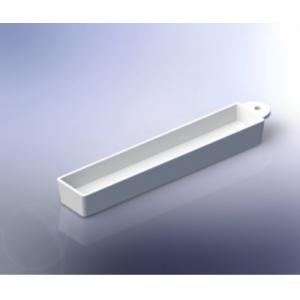

Add to Cart
Fully Yttria Stabilized Zirconia, 8YSZ (8% by mole Yttria) ceramics
Fully Yttria Stabilized Zirconia, 8YSZ (8% by mole Yttria) ceramics are used when an application requires a crucible that is exceptionally strong, wear-resistant and chemically inert at extremely elevated temperature. Also is the material that preferred for most biocompatible applications. Fully Yttria Stabilized Zirconia is the material with the higher strength from the materials we offer and exhibits a Flexural strength that is higher than Nitrides and can approach the value of Carbides. This property significantly extends the reliability and lifetime of crucibles made with stabilized Zirconia.
Fully Yttria Stabilized Zirconia (8YSZ) technical ceramics offers
some advantages over Alumina. Namely, Fully Yttria Stabilized
Zirconia 8YSZ crucibles compared to Alumina crucibles are more
refractory and have lower thermal conductivity, have higher quality
surface finish, are denser and are even 4 times superior in terms
of strength (this property degrades when temperature exhibits 1000
C). However, are considerably more expensive even than purest
grades of Alumina and are less thermal shock resistant. The main
reason for 8YSZ high cost is that both Zirconia and Yttria raw
material are rare compared with Alumina and thus expensive.
It should be noted that Zirconia can be vulnerable to chemisorption
in the presence of water molecules, thus YSZ Properties degrade
rapidly when exposed to water vapor at 200 – 300 C.
Fully Stabilized Zirconia (8YSZ) t-ceramics Crucibles Key Features:
Related Data
| Main component | 99%Al2O3 | S-SiC | ZrO2 | Si3N4 | ||
| Physical Property | Density | g/cm3 | 3.9 | 3.1 | 6 | 3.2 |
| Water Absorption | % | 0 | 0.1 | 0 | 0.1 | |
| Sinter Temperature | °C | 1700 | 2200 | 1500 | 1800 | |
| Mechanical Property | Rockwell Hardness | HV | 1700 | 2200 | 1300 | 1400 |
| Bend Strength | kgf/mm2 | 3500 | 4000 | 9000 | 7000 | |
| Compression Intensity | Kgf/mm2 | 30000 | 20000 | 20000 | 23000 | |
| Thermal Property | Maximum working temperature | °C | 1500 | 1600 | 1300 | 1400 |
| thermal expansion coefficient 0-1000°C | /°C | 8.0*10-6 | 4.1*10-6(0-500°C) | 9.5*10-6 | 2.0*10-6(0-500°C) | |
| 5.2*10-6(500-1000°C) | 4.0*10-6(500-1000°C) | |||||
| Thermal Shock resistance | T(°C) | 200 | 250 | 300 | 400-500 | |
| Thermal Conductivity | W/m.k(25°C | 31 | 100 | 3 | 25 | |
| 300°C) | 16 | 100 | 3 | 25 | ||
| Electrical Property | Resisting rate of Volume | ◎.cm | ||||
| 20°C | >1012 | 106-108 | >1010 | >1011 | ||
| 100°C | 1012-1013 | – | – | >1011 | ||
| 300°C | >1012 | – | – | >1011 | ||
| Insulation Breakdown Intensity | KV/mm | 18 | semiconductor | 9 | 17.7 | |
| Dielectric Constant (1 MHz) | (E) | 10 | – | 29 | 7 | |
| Dielectric Dissipation | (tg o) | 0.4*10-3 | – | – | – | |
Applications.
Analytical applications, metals melting, ceramic powders heat treatment, material acid treatment even at elevated temperature. Zirconia crucibles are ideal for the melting or sintering of precious metals and super-alloys. Other common applications are dental restorations sintering, crystal growing, crucibles for extremely corrosive environments, like plasma etching etc.
